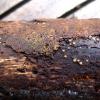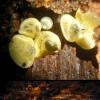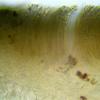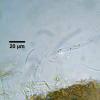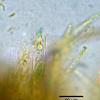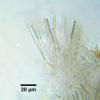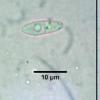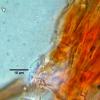
06-12-2025 00:19
 Viktorie Halasu
Viktorie Halasu
Hello, would anyone have this article, please? An

05-12-2025 17:33
 Bruno Coué
Bruno Coué
Bonjour, je serais heureux de recueillir votre avi

02-12-2025 18:59
This pair of ascos 2.5cm across were on recently b

02-12-2025 19:25
Buckwheat PeteHello, can anyone identify this hairy fungus growi

30-11-2025 12:53
 Edvin Johannesen
Edvin Johannesen
White short-stipitate apothecia found on thin twig

30-11-2025 10:47
 William Slosse
William Slosse
I recently found a collection of small Peziza sp.
Hymenoscyphus on wood
Martin Bemmann,
05-07-2010 23:57
 Hi all,
Hi all,this one puzzels me lacking clear features. The apothecia grow with a short stipe on a soaked dead and mostly decorticated twig of a broadleave tree. Their colour is cream to yellowish.
I found hundreds of paraphyses (septated and with refractive bodies in the upper segment) but only few asci (c. 75 x 5 µm). No chance to check whether they arise from croziers or not (I made several preparations...). With IKI I could observe a faint blue reaction of the apical apparatus. The few spores I found are scutuloide, 1-septate when mature and filled with 1 big and some smaller oildrops (10,1-12,5 x 3,2-4,2 µm).
My hope is that the overall appearence will remind some of you on a group of species I should look after.
Best regards,
Martin
Martin Bemmann,
05-07-2010 23:58
Marja Pennanen,
06-07-2010 01:18
Re:Hymenoscyphus on wood
Hello Martin,
this looks like Hymenoscyphus vernus, which I've found on wet wood.
Except that the spores were not septate and I've not mentioned too many papaphyses ;)
Anyway the paraphyses had many droplets and were a little longer than asci.
But my determinations may not always be rock solid ;)
Greetings:Marja
this looks like Hymenoscyphus vernus, which I've found on wet wood.
Except that the spores were not septate and I've not mentioned too many papaphyses ;)
Anyway the paraphyses had many droplets and were a little longer than asci.
But my determinations may not always be rock solid ;)
Greetings:Marja
Hans-Otto Baral,
06-07-2010 08:31

Re:Hymenoscyphus on wood
Hi Martin & Marja
good to see that you try idetification yourself, Marja! I think it is the close H. kathiae. H. vernus has often a longer stipe (but must not), and the spores not so much oil. Septa often occur in overmature stages in many species.
Important would be the ascus base (H- in vernus, H+ in kathiae and imberbis). With KOH+CR I usually easily see whether there are croziers or not. Or in the living state in a section without squashing.
Zotto
good to see that you try idetification yourself, Marja! I think it is the close H. kathiae. H. vernus has often a longer stipe (but must not), and the spores not so much oil. Septa often occur in overmature stages in many species.
Important would be the ascus base (H- in vernus, H+ in kathiae and imberbis). With KOH+CR I usually easily see whether there are croziers or not. Or in the living state in a section without squashing.
Zotto
Martin Bemmann,
06-07-2010 15:07
